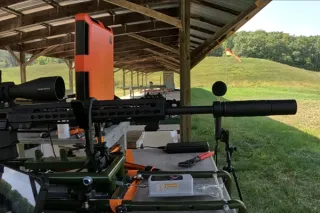How We Test
Sound levels are affected by elevation, temperature, humidity, ammunition used, firearm used, barrel length, cleanliness of the silencer, and wind speed, among other things. Because there are so many variables, it is not uncommon for silencers to meter differently from test to test.
Data obtained and used in the results has been physically tested and measured within. No manufacturer or other party has influenced or controlled information or data used or published.
The Military standard MIL-STD-1474E establishes acoustical noise limits and prescribes testing requirements and measurement techniques. This is the industry-accepted standard for testing silencers. Our test data is obtained based on MIL-STD-1474E.
Goal: Provide useful and meaningful suppressor information.
Supersonic Considerations
For measurements with non-subsonic (supersonic) ammunition, our tests include the supersonic shockwave (“crack”).
This crack measures approximately 130–134 dB at one meter left of the muzzle. It is unlikely to
see unfiltered peak levels (LZpeak) below this at that position.
Platform Effects
Bolt-action rifles will always be quieter than semi-autos due to gas escaping through the action (port pop).
On AR-10/AR-15 “gas gun” platforms, port pop significantly affects the shooter’s-ear reading. Port pop can often be reduced by tuning the gas system. During our tests, the gas system is adjusted to the minimum that allows full functionality with no muzzle device, and this same setting is used throughout all tests.
On semi-auto center-fire pistols, gas escaping the breech influences both muzzle dB and shooter’s-ear dB. Different pistols may produce different results. We use the M9 (9mm) and a full-size 1911 (.45 ACP).
Firearms Used
- Rimfire: Ruger 10/22, Ruger RPR 22, Taurus TX-22
- Centerfire rifle: Armalite AR-10 20″ barrel (.308 Win), Ruger RPR (.308 Win)
- Centerfire pistol: Beretta M9 (9mm), 1911 (.45 ACP)
Ammunition: The same ammunition is used for each test configuration.
Firearm Configurations
- No Muzzle Device (NMD)
- Muzzle Device (MD) used when a suppressor is mounted (brake, flash suppressor, direct thread, …)
- Suppressed Configuration with suppressor mounted
- Re-Mounted Suppressed (used to find Point of Impact shift; included with bolt-action tests)
Test Sound Locations
- Muzzle (ML): One meter left of the muzzle and level with it; microphone oriented upward (often called “one meter east”).
- Shooter’s Ear (SE): Eight inches behind the rear sight, offset three inches right; mic oriented upward. Affected by overall rifle/barrel length.
- Spotter (SP): One meter behind the rear sight and 30 cm to the right. Different muzzle devices can affect this greatly.
Operational Orientation
Height above supporting surface (default is Standing unless otherwise specified).
| Position | Height |
|---|---|
| Prone | 33 cm (13.0 in) |
| Sitting | 80 cm (31.5 in) |
| Kneeling | 124 cm (48.8 in) |
| Standing | 160 cm (63.0 in) |
Note: The supporting surface includes seating or other means of elevating the operator above ground level. If no structure is present, ground/floor elevation is the reference height.
Measurements for Scoring Suppressors
- Decibel Levels (dB) at each position
- Δ dB: Difference between suppressed and unsuppressed
- Recoil & recoil reduction
- Weight & diameter
- Port Pop (semi-auto rifles)
- Features
- Accuracy: Group size & Point of Impact (POI) shift
Because of the variables above, we measure each configuration with no muzzle device and with the suppressed muzzle device, and provide the Delta dB for a relative measure of suppression achieved.
Instrument: Larson Davis LXT.
Terms & Weightings Used
A-Weighting
A weighting filter that most closely matches human perception at low to moderate levels—commonly used for
environmental sound. Notation examples: dBA, LAeq, LAF, LAS.
Z-Weighting
“Zero” or no frequency weighting (practically 10 Hz–20 kHz passband). Notation examples: dBZ,
LZpeak, LZS.
Lpeak
Highest instantaneous sound level (no time weighting). Remember: sound is a wave—pressure oscillations in air.
Decibel (dB)
A logarithmic unit used for sound/vibration levels. When “level” is referenced, this logarithmic form is implied. It lets us represent a large span of signals compactly (vs. Pascals for acoustics).
- Doubling of the sound pressure = +6 dB
- Doubling of the sound power = +3 dB
- Doubling of the perceived loudness ≈ +10 dB



Facebook
Instagram
X
Youtube
TikTok